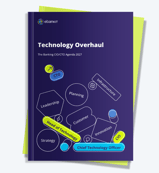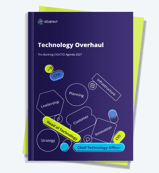Building a next-level small digital business strategy
Recorded on 4th March, 2025

SPEAKERS
Paul Provenzano, VP Market Development
SUMMARY
Not all SMBs are alike, and identifying underserved segments presents an opportunity to deliver more tailored financial solutions. By assessing current technology stacks and addressing gaps, community banks can create a digitally differentiated experience that aligns with evolving business needs. Discover a next-level digital small business strategy to better serve SMBs.
Key topics
There is a gap between what small businesses actually need and what traditional financial institution are currently offering in the market.
Determine which SMBs your financial institution is serving to better comprehend their needs and what products to offer in a more effective manner.
Enhance user experience for small business owners with a centralized user experience across multiple devices and seamless account switching from business to personal in one click.

Download the guide to better serve small business owners
Transcript
00:00:00 - Introduction and line-up for the session
The host welcomes attendees and introduces the session, which focuses on actionable insights, proven tactics, and expert advice to help community financial institutions better support small business accounts. The webinar explores strategies and digital capabilities to serve this profitable yet underserved market.
In recent months, conversations with community banks have increasingly centered on digital small business strategies, client acquisition, and retention. The webinar highlights critical market insights, including risks community banks face regarding small business account growth and retention. The discussion will begin with an overview of challenges in the small business banking sector, followed by an analysis of current small business product positioning. The core of the webinar will delve into key principles for developing a differentiated digital strategy to attract and retain small business clients.
00:05:00 - Identifying the SMB market challenges
Paul Provenzano starts by talking about findings from multiple research firms, all pointing to a common issue: small businesses are less inclined to partner with their community banks, even those they have personal relationships with. This led to a deeper analysis of the underlying reasons, both through research and market analysis.
A McKinsey study identified the top criteria small businesses seek from their banks. While relationships remain a major strength of community banks, the next most critical factors are technology and digital services that enhance efficiency and support business growth. This insight highlighted a gap between what small businesses need and how financial institutions position their small business offerings.
An analysis of community bank websites showed that most small business accounts are presented with a strong transactional focus. While transactions are fundamental, the research revealed a disconnect between traditional offerings and the evolving needs of small businesses. This realization drove the conversation toward redefining what a modern digital small business strategy should encompass.
Paul then introduced three key elements of a next-level digital small business strategy, beginning with the importance of understanding business clients. Segmentation plays a crucial role, helping banks identify and group businesses they serve most effectively. Various segmentation methods exist, including industry-specific approaches, to better align services with business needs.
00:10:00 - Business client segmentation
The webinar continues by emphasizing the importance of business segmentation in shaping financial service offerings. Once banks define their target business personas, they can tailor services to better meet specific needs.
A practical example is presented through an interior designer running a one-person business. Like many solo entrepreneurs, she manages all aspects of her business, from handling large transactions to managing expenses and invoices. To support her, banks should offer services beyond standard transactions, such as cash flow monitoring, invoicing tools, and accounting software integration.
Another example is Precision Engineering, a larger, more structured 20-person company with both domestic and international operations. This business has different banking needs, including access to credit, cash flow forecasting, multi-user account management with role-based approvals, and integrations with sophisticated accounting and payroll systems.
These examples illustrate how different business structures require distinct banking solutions. Understanding these needs helps banks develop technology-driven services that add value and strengthen client relationships. The webinar then introduces four key technology considerations, starting with user experience design, to ensure banking solutions effectively support business clients.
00:15:00 - The importance of User Experience
The webinar continues by emphasizing the importance of user experience (UX) in digital banking for small businesses. Many financial institutions overlook this area, yet improving UX can provide immediate value to business owners.
One key UX enhancement is cash flow dashboards, which offer at-a-glance insights into account trends without requiring users to manually check balances. Another example is providing seamless access to multiple business and personal accounts under a single login, catering to business owners who operate multiple ventures. This unified experience across devices—PC and mobile—enhances convenience and strengthens the client’s relationship with the bank.
Looking ahead, AI presents an opportunity to further enhance UX through predictive modeling. By analyzing historical data on invoicing and expenses, AI can forecast future cash flow trends, offering valuable insights to small business owners.
The second major technology consideration is integration and optimization of third-party systems. Open API platforms enable seamless connections between a bank’s digital services and external accounting, invoicing, payroll, and HR systems. This integration transforms the bank into the “digital front door” for small businesses, reinforcing customer engagement and loyalty.
Additionally, an open API allows for diverse payment system integrations, catering to the varied money movement needs of different business segments. By tailoring payment options based on business type, banks can create a more compelling and competitive service offering.
00:20:00 - Adapt your products to your client segments' needs
Paul highlights the importance of enabling different payment and operational capabilities based on business segments. For example, while the interior designer's small business may not require international wire transfers, Precision Engineering might. An open system allows banks to customize services according to each business persona’s needs, improving flexibility and efficiency.
The third major technology consideration is the back-office and operational side. Businesses need robust controls and workflows to manage financial transactions efficiently. Technology should support multi-layered entitlements, allowing businesses to set custom transaction rules based on type, amount, or a combination of both. These features enhance security, improve automation, and create an audit trail for better financial oversight.
The final key consideration is the relationship between small businesses and banks. While some believe technology hinders relationship-building, the webinar argues the opposite—when used correctly, technology strengthens and maintains these relationships.
One example is the onboarding process for new business clients. Traditionally, this involves in-person visits, extensive documentation, scanning, and back-and-forth emails. Instead, banks can implement a seamless digital onboarding experience where documents are securely shared through an online banking portal, and workflows track the progress. This eliminates inefficiencies and provides transparency, ensuring a smooth first impression that sets the stage for a strong, long-term relationship.
Another way technology enhances relationships is by facilitating personal connections. The webinar suggests that technology should not replace human interaction but rather transition and strengthen it, ensuring that business owners feel supported while benefiting from digital convenience.
00:25:00 - Digital strategy for SMBs
The next part focused on how technology can enhance customer relationships in real time. Instead of making phone calls for support, small business owners should have the ability to message their personal banker, initiate a chat, transition into a video call, or even share their screen—all within the banking system. This strengthens the relationship between businesses and their financial institutions by providing immediate, seamless support.
The four key pillars of the technology strategy—user experience, open APIs, customer support integration, and platform development—lay the foundation for an effective small business banking strategy. Once the technology framework is established and aligned with market segmentation insights, financial institutions can build a next-level digital small business strategy.
This strategy involves aligning target market needs with specific account features and benefits. Instead of offering generic, transaction-oriented accounts, banks can create tailored solutions for different business segments. The webinar presents an illustrative model that categorizes businesses into solopreneurs, mid-sized businesses (e.g., Precision Engineering), and enterprise-level companies. Each category receives a customized set of banking services and technology features designed to improve efficiency and support business growth.
Rather than leading with transactional services, the focus shifts to solving real business challenges through advanced digital capabilities. By repackaging existing products with technology at the forefront, community banks can clearly communicate their value proposition, offering a more compelling and differentiated digital banking experience.
The webinar concludes by reiterating the importance of leveraging market insights, using segmentation to drive technology requirements, and repositioning small business banking products to stand out in a competitive market. Ultimately, technology enables a digitally advanced, differentiated product that meets modern business needs. Attendees were also invited to download ebankIT's report on Corporate banking "Digital Dynamics and Corporate Banking for 2025."
00:30:00 - Q&A
An attendee asked where should a bank even start on this journey. Paul highlighted 3 steps. 1. Business Segmentation Strategy – Identify the bank’s core market and the types of businesses it serves best. 2. Technology Inventory – Evaluate the current technology stack, identify opportunities for enhancement, and recognize any gaps. 3. Competitive Analysis – Research how other financial institutions in the same market position their business accounts to identify trends and potential differentiators. Another viewer asked about the major obstacles community banks face when implementing digital solutions for small businesses. Paul put emphasis on System Openness – The ability of a bank’s current digital platform to integrate with third-party systems can either enable or restrict innovation. System Depth – Banks must ensure their digital platforms can support multi-level entitlements, approvals, and access to multiple accounts under a single login. Self-Service Onboarding – While consumer banking has advanced in digital onboarding, community banks have an opportunity to create a seamless, self-service onboarding experience for businesses. A last question was asked about the future technology trends. Looking ahead, Paul emphasizes several key trends for SMB banking: Greater integration between digital banking platforms and third-party systems (e.g., invoicing, accounting, and expense management). Increased automation in invoice processing and accounts payable, reducing manual intervention. AI-driven cash flow forecasting and predictive modeling to help businesses manage their finances more effectively. By leveraging these trends, community banks can enhance their digital offerings and strengthen relationships with business customerss.




%20without%20SAM%20-%20Maturity%20Level%20-%202-KO%20edit.webp?width=160&height=57&name=67768-ebankIT%20Platform%20-%20CMMI%20Development%20V2.0%20(CMMI-DEV)%20without%20SAM%20-%20Maturity%20Level%20-%202-KO%20edit.webp)
